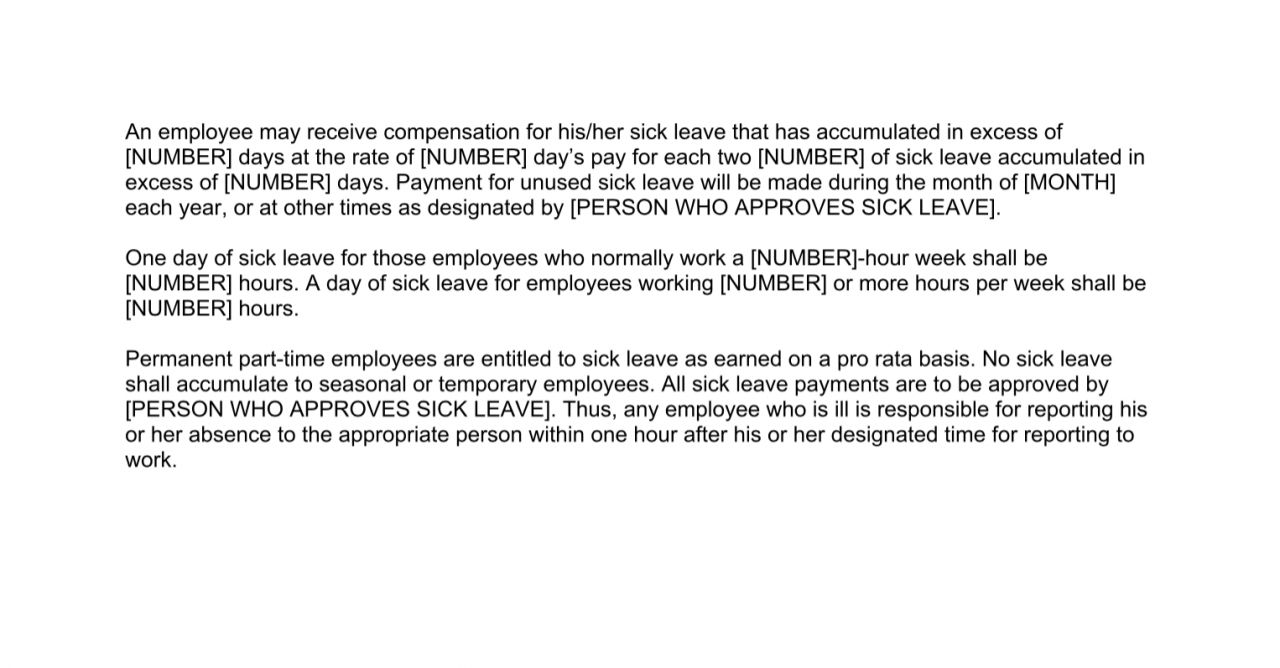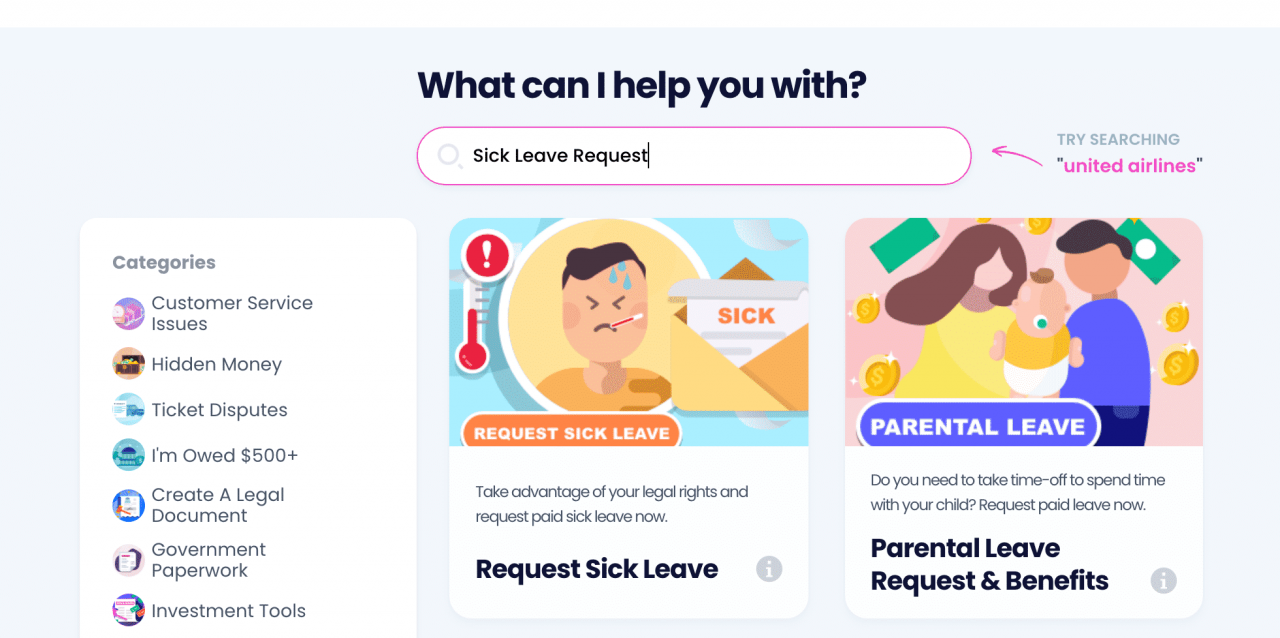A statement defining how an organization handles employee sick days – Navigating the complexities of employee sick leave can be a daunting task, but with a well-defined policy in place, organizations can ensure fair and consistent treatment of their workforce. This guide delves into the essential elements of a comprehensive sick leave policy, empowering businesses to create a framework that supports employee well-being and maintains operational efficiency.
Policy Statement
This policy defines the organization’s approach to handling employee sick days, ensuring consistent and fair treatment of employees who are unable to work due to illness or injury.
The policy applies to all regular and part-time employees of the organization. It covers absences due to illnesses and conditions that prevent employees from performing their job duties effectively.
When an organization outlines a statement defining how employee sick days are handled, it’s crucial to assess a potential employee’s understanding of such policies. Consider incorporating 10 interview questions to ask an employee related to sick day protocols, such as their knowledge of reporting procedures and their approach to balancing work responsibilities with personal health.
Types of Illnesses and Conditions Covered
The policy covers a wide range of illnesses and conditions, including but not limited to:
- Physical illnesses, such as the flu, colds, and infections
- Mental health conditions, such as depression and anxiety
- Chronic conditions, such as diabetes and heart disease
- Injuries, such as sprains, strains, and fractures
The policy also covers absences due to medical appointments, such as doctor’s visits, surgeries, and physical therapy.
A company’s policy on employee sick days can reveal a lot about its culture. For instance, a generous policy may indicate that the company values employee well-being. On the other hand, a strict policy may suggest that the company is more focused on productivity.
To get a better idea of what employers are looking for in an employee, check out this list of 10 top characteristics employers look for in an employee . Returning to the topic of sick days, it’s worth noting that a well-defined policy can help to avoid confusion and conflict.
Eligibility Requirements

Employees must meet specific eligibility requirements to access sick days.
Eligibility is determined by factors such as employment status, length of service, and probationary periods.
If your organization has a statement defining how they handle employee sick days, it’s important to make sure that it’s clear and easy to understand. You can also take a dealing with microaggression as an employee course to learn how to identify and respond to microaggressions in the workplace.
This can help you create a more inclusive and welcoming environment for all employees.
Probationary Period
- Employees must complete a probationary period of 90 days before becoming eligible for sick days.
- During the probationary period, employees are not eligible for any sick days.
Part-Time Employees
- Part-time employees are eligible for a prorated number of sick days based on their hours worked.
- For example, a part-time employee who works 20 hours per week is eligible for 5 sick days per year.
Temporary Employees
- Temporary employees are not eligible for sick days.
Notification Procedures
To ensure timely and proper notification, employees are required to follow the established procedures for reporting sick days.
Employees must notify their supervisor as soon as possible, preferably before the start of their scheduled shift. Acceptable methods of communication include:
Phone
- Employees may call their supervisor’s direct line or the designated company phone number.
- Leave a clear and concise message stating their name, the reason for their absence, and the expected duration of their sick leave.
- Employees may send an email to their supervisor or the designated company email address.
- The email should include the same information as a phone call: name, reason for absence, and expected duration.
- Employees are encouraged to provide any additional relevant information, such as a doctor’s note or test results, to support their claim.
Verification Requirements: A Statement Defining How An Organization Handles Employee Sick Days
To ensure the authenticity of employee illnesses, our organization has established specific verification requirements. These requirements aim to maintain a fair and transparent process while safeguarding the organization’s interests.
Employees are expected to provide acceptable documentation to support their sick leave requests. This documentation should clearly indicate the employee’s illness or medical condition, the date of onset, and the expected duration of absence. Acceptable forms of documentation include:
Doctor’s Notes
- Must be from a licensed healthcare professional (e.g., doctor, nurse practitioner, physician assistant).
- Should include the patient’s name, diagnosis, date of examination, and any restrictions or recommendations.
- Can be submitted electronically or by mail.
Medical Records
- Can be requested by the organization if deemed necessary.
- Should provide detailed information about the employee’s medical condition and treatment.
- Must be submitted with the employee’s consent.
In certain circumstances, the organization may require additional verification, such as a phone consultation with the healthcare provider or a second medical opinion. The purpose of these additional measures is to ensure the legitimacy of the employee’s illness and to prevent abuse of sick leave privileges.
Paid vs. Unpaid Leave
Employees are eligible for paid sick leave if they have worked for the company for at least 90 days. The maximum number of paid sick days allowed is 10 per year.
Eligibility for Paid Sick Leave
- Employees must have worked for the company for at least 90 days.
- Employees must be unable to work due to a physical or mental illness, injury, or other medical condition.
- Employees must provide documentation from a healthcare provider to verify their illness or injury.
Maximum Number of Paid Sick Days
Employees are allowed to take up to 10 paid sick days per year. This includes days taken for the employee’s own illness or injury, as well as days taken to care for a sick family member.
Hey there, boss! Got a query for ya? Check out this query letter I drafted up. It’s got all the juicy details on how we’re handling employee sick days. Let me know what you think!
Accrual and Carryover
Sick days are accrued at a rate of one day per month of service. This accrual begins on the first day of employment and continues until the employee reaches the maximum allowable accrual of 12 days.
An organization’s statement defining how employee sick days are handled should be clear and concise. A security administrator suspects an employee has been emailing proprietary information outside the company, which could violate company policy. Therefore, it’s important for organizations to have a clear policy in place regarding employee sick days and other absences.
Accrued sick days can be carried over from year to year, up to a maximum of 24 days. However, any unused sick days beyond 24 days will be forfeited at the end of the year.
When an organization has a statement defining how it handles employee sick days, it ensures that all employees are treated fairly and consistently. This is important because it protects the rights of employees to take time off when they are sick without fear of losing their job or being penalized.
The 5 rights of an employee include the right to a safe and healthy workplace, the right to fair wages and benefits, the right to organize and bargain collectively, the right to privacy, and the right to equal opportunity. By ensuring that employees have these rights, organizations can create a more positive and productive work environment.
Carryover Limits
- Employees may carry over a maximum of 24 sick days from year to year.
- Any unused sick days beyond 24 days will be forfeited at the end of the year.
Leave of Absence
For employees who require an extended leave of absence due to illness, our organization has established a clear process to ensure their well-being and a smooth transition upon their return.
To initiate a leave of absence, employees must submit a written request to their supervisor. This request should include the following information:
Documentation and Communication Requirements
- A medical certification from a licensed healthcare professional verifying the illness and the expected duration of the leave.
- A detailed plan for staying connected with the organization during the leave, including preferred methods of communication and the frequency of updates.
Upon receiving the request, the supervisor will review it and, in consultation with Human Resources, determine if the leave is approved. The employee will be notified of the decision in writing.
During the leave of absence, the employee is expected to maintain regular communication with their supervisor and provide updates on their condition and expected return date. The supervisor will also provide support and guidance to the employee throughout the process.
Return-to-Work Procedures
Upon the expiration of an employee’s sick leave, they are expected to return to work. This section Artikels the procedures and requirements for employees returning to work after a sick leave.
In some cases, employees may be required to provide medical clearance or documentation from a healthcare provider before returning to work. This is typically required for extended absences or when the employee’s illness or condition may impact their ability to perform their job duties safely and effectively.
Medical Clearance
- Employees may be required to provide a doctor’s note or other medical documentation to confirm their fitness to return to work.
- The medical clearance should specify any restrictions or limitations on the employee’s work duties or activities.
- The employee is responsible for providing the medical clearance to their supervisor or HR department.
Documentation
- In some cases, employees may be required to provide documentation to support their sick leave, such as a doctor’s note or a self-certification form.
- The documentation should state the dates of the employee’s absence and the reason for the absence.
- The employee is responsible for providing the documentation to their supervisor or HR department.
Employee Responsibilities

Employees are expected to use sick leave responsibly and only when they are genuinely unable to work due to illness or injury. Misusing or abusing sick leave can have serious consequences.
An organization’s statement on employee sick days is crucial for maintaining a healthy and productive workplace. As part of their responsibilities, employees must adhere to this policy while fulfilling their 5 responsibilities , including being punctual, maintaining a positive attitude, and respecting company property.
By following these guidelines, employees not only protect their own health but also contribute to the overall well-being of the organization.
Employees are responsible for:
- Providing timely notice of their absence.
- Providing documentation to support their absence, if requested.
- Not using sick leave for non-legitimate purposes.
Consequences of Abusing or Misusing Sick Leave
Employees who abuse or misuse sick leave may face disciplinary action, up to and including termination of employment.
Management Responsibilities
Management plays a crucial role in ensuring the effective implementation of the sick leave policy. They are responsible for ensuring that the policy is communicated to employees, that employee requests are handled fairly and consistently, and that any concerns or issues are addressed promptly and appropriately.
When an employee requests sick leave, management should review the request and verify that it meets the eligibility requirements Artikeld in the policy. They should also ensure that the employee has provided the necessary documentation to support their request, such as a doctor’s note or other medical certification.
Handling Employee Requests, A statement defining how an organization handles employee sick days
Management should handle employee requests for sick leave in a timely and professional manner. They should be responsive to employee needs and should work with employees to ensure that their requests are processed efficiently.
When an employee requests sick leave, management should:
- Review the request and verify that it meets the eligibility requirements.
- Ensure that the employee has provided the necessary documentation to support their request.
- Approve or deny the request in a timely manner.
- Communicate the decision to the employee in writing.
Addressing Concerns
Management should be open to addressing any concerns or issues that employees may have about the sick leave policy. They should be willing to listen to employee feedback and should work with employees to resolve any concerns or issues that may arise.
If an employee has a concern or issue about the sick leave policy, they should:
- Speak to their supervisor or manager.
- File a grievance with the Human Resources department.
- Contact the union representative (if applicable).
Last Word

By establishing clear guidelines and fostering a culture of open communication, organizations can effectively manage employee sick leave, promoting a healthy and productive work environment. Remember, a well-crafted sick leave policy is not merely a legal requirement but a valuable tool for safeguarding employee rights and maintaining a harmonious workplace.
FAQ Section
What are the key components of a comprehensive sick leave policy?
A comprehensive sick leave policy should include a clear statement of purpose, eligibility criteria, notification procedures, verification requirements, provisions for paid and unpaid leave, accrual and carryover rules, leave of absence guidelines, return-to-work procedures, employee responsibilities, and management responsibilities.
How can organizations prevent abuse of sick leave?
Organizations can prevent abuse of sick leave by implementing clear policies, requiring verification for extended absences, and fostering a culture of trust and accountability. Regular communication and education can also help employees understand the importance of responsible sick leave use.
What are the benefits of a well-managed sick leave policy?
A well-managed sick leave policy promotes employee health and well-being, reduces absenteeism, improves morale, enhances productivity, and ensures compliance with legal requirements.